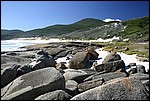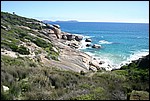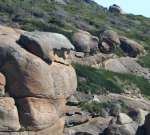 sb1.jpg |
Welcome to Squeaky Beach. Why is it called Squeaky Beach? You'll have to read to the end to find out. Squeaky Beach is a great place to learn about physical weathering processes. The images below illustrate just a couple of the physical weathering processes that can be seen occurring around Wilsons Promontory National Park. In this image we're looking roughly east from the headland at Tidal Overlook towards Squeaky Beach. You can see granite shore platforms and boulders that have been tossed around by storms, filled in by white quartz beach sand. |
 sb2.jpg |
The northern shore of the Tidal Overlook headland at Squeaky beach has some really interesting weathering features. In this image tafoni and unloading joints are visible. |
 sb3.jpg |
Salt weathering is another common form of weathering at Squeaky Beach. Salty sea water gathers in small depressions in the rock platform, eventually enlarging these into depressions like the one pictured. How does this happen? Salts (in this case typically NaCl, or halite, but also probably thenardite - Na2SO4 - and mirabilite - Na2SO4.10H2O) have a very powerful pressure of crystallization. This can be regarded as the outward force a crystal exerts as it precipitates from solution within a porous mass. Typical granite has a tensile strength (the force required to pull it apart) of about 4 MPa (mega-Pascals) whereas halite, thenardite and mirabilite can exert up to about 120 MPa of pressure when crystallizing, depending on a variety of conditions. Thus, salts crystallizing in the surface of a rock mass can actually cause the mass to blow apart - BANG! Well, not really, it's more of a whimper... |
 sb4.jpg |
What happens when salt weathering is taken to its ultimate degree? This! Well, maybe not in reality, but it's a great looking boulder. |
So why is Squeaky Beach called Squeaky Beach? Because the sand squeaks! The white quartz sand on Squeaky Beach is very clean, very fine and the grains are nearly spherical. When you walk on it the grains rub together making a squeaking sound. Why is the sand so white and spherical? Because it's being reworked from the aeolian dunes at the back of the beach, unlike the sand on most of the other beaches on the west coast of The Prom. Great fun for kids (and some adults too). |
|
Learn more about Squeaky Beach and its weathering by reading: W.D. Birch ed. 2003. Geology of Victoria. Geological Society of Australia special publication No. 23. 842 p. |
|

